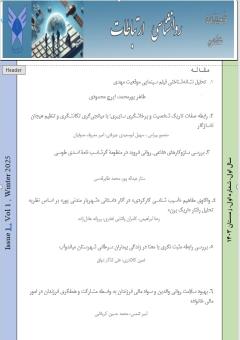بررسی سازوکارهای دفاعی- روانی فروید در منظومۀ گرشاسب نامۀ اسدی طوسی
محورهای موضوعی : روانشناسی زبان، هنر و ادبیاتستار عبدالهپور 1 * , محمد طایر قدسی 2
1 - استادیار گروه زبان و ادبیات فارسی، واحد میاندوآب، دانشگاه آزاد اسلامی، میاندوآب، ایران
2 - استادیار گروه زبان و ادبیات فارسی، واحد میاندوآب، دانشگاه آزاد اسلامی، میاندوآب، ایران
کلید واژه: سازوکارهای دفاعی, روانی فروید, گرشاسبنامۀ اسدی طوسی, نقد روانشناختی, ناکامی و تعارض,
چکیده مقاله :
سازوکارهای دفاعی - روانی بهمنظور برقراری تعادلِ روانی بین انسان و دنیای اطرافش بهطور ناخودآگاه بکار میروند. این سازوکارها در شرایط دِلهره، اضطراب و ناکامی بیشتر نمود پیدا میکنند. با توجه به اینکه جنگ منبع عظیم دِلهره، اضطراب و ناکامی است و این مؤلفهها در منظومههای حماسی بروز مییابند؛ بنابراین منظومۀ حماسی «گرشاسبنامۀ اسدی طوسی»، یکی از بهترین منابع برای شناخت و ارائه سازوکارهای دفاعی- روانی است. این مقاله با روش توصیفی- تحلیلی، در پیِ آن است تا به بررسی و تحلیل سازوکارهای دفاعی- روانی در این منظومه بپردازد و به این پرسش اصلی پاسخ دهد که شخصیتهای داستانی هنگام رویارویی با ناکامیها و تعارضها از چه سازوکارهایی استفاده نمودهاند و با بررسی کَمی این سازوکارها انگیزههای استفاده مشخص گردد و به شناسایی عمیقتر از شخصیتهای این منظومه کمک نماید. نتایج برآمده از این پژوهش نشان میدهد که در منظومۀ گرشاسبنامه پرخاشگری، تحقیر کردن دیگران و قدرت مطلق بیشترین فراوانی استفاده را بهویژه توسط گرشاسب داشتهاند که علّت آن را میتوان در تلاش برای گرفتن لقبِ جهانپهلوانی و خوشایندی ضحاک دانست.
Defense-psychological mechanisms are employed unconsciously to make a psychological balance between humans and their surrounding environment. These mechanisms are more pronounced in conditions of stress, anxiety, and failure. Considering that war is a great source of stress, anxiety and failure, and these components appear in epopee; Therefore, the epopee "Garshasbnameh of Asadi-Tusi" is one of the best sources to identify and prose defense-psychological mechanisms. This paper uses a descriptive-analytical method to study and analyze the defense- psychological mechanisms in this epopee. This paper aims to answer the main question of what mechanisms have used by fictional characters when facing failures and conflicts, and the reasons for using these mechanisms to be identified with a quantitative examination and help to identify more deeply the characters of this epopee. The results of this study show that in this epopee, aggression, contempt and Omnipotence have been used the most, especially by Garshasb, which can be considered as an attempt to get the title of world heroism and Zahak pleasure.
1- Aidenlu, Sajjad and others(2005) Garshasb's Heroism, 3rd edition, Tehran: Ahl al-Qalam Cultural Institute [in Persian].
2- Ahmadvand, Mohammad Ali, (2004), Mental Health, Third Edition, Tehran: Payam Noor Publications[in Persian].
3- Ahmadvand, Mohammad Ali (1993), Understanding human thought (psychological defense mechanisms), Tehran: Bamdad Publishing House[in Persian].
2- Ahmadvand, Mohammad Ali, (2004), Mental Health, Third Edition, Tehran: Payam Noor Publications [in Persian].
3- Ahmadvand, Mohammad Ali (1996), Understanding human thought (psychological defense mechanisms), Tehran: Bamdad Publishing House[in Persian].
4- Asadi Tousi, Abu Nasr Ali Ibn Ahmad, (1975), Garshasabnameh, by Habib Yaghmai, Tehran: Tahuri [in Persian].
5- Eagleton, Terry, (2008), A Prelude to Literary Theory, translated by Abbas Mokhbar, Tehran: Center[in Persian].
6- Khaleghi Mutlaq, Jalal, (1983), a tour in Garshasabnameh, Irannameh magazine, 1362/3, pp. 423-388; 4/1362, pp. 513-559; 5/1362, pp. 147-94. [in Persian]
7- Razmjo, Hossein, (2008), The Realm of Iranian Epic Literature (Volume 1), Tehran: Research Institute of Humanities and Cultural Studies [in Persian].
8- Shamlou, Saeed, (2014), schools and theories in personality psychology, 8th edition, Tehran: Rushd [in Persian].
9- Shaarini Nejad, Ali Akbar, (2019), General Human Psychology, Tehran: Information. [in Persian]
10- Shoaibi, Fatemeh, (2012), Defense Mechanisms, Tehran: Electronic Publications [in Persian].
11- Shamisa, Siros, (2013), literary criticism, 4th edition, Tehran: Ferdous Publications[in Persian].
12- Safa, Zabihullah, (1990), History of Iranian literature (volume 2), 10th edition, Tehran: Ferdous [in Persian].
13- Forozanfar, Badi al-Zaman, (2008), Sokhon and Sokhronan, Tehran: Zovar [in Persian].
14- Freud, Sigmund, (2007), psychological defense mechanisms, translated by Seyyed Habib Gohari Rad and Mohammad Javadi, 6th edition, Tehran: Rad Mehr [in Persian].
15- Freud, Sigmund, (2003), psychoanalysis and my life, translated by Enayat, first edition, Tehran: Duniya Kitab. General Psychology, 58th edition, Tehran: Savalan Publishing [in Persian].
16- Karimi, Youssef, (1995), Personality Psychology, Tehran: Payam Noor Publications. [in Persian]
17- Ganji, Hamzeh, (2019), General Psychology, 58th edition, Tehran: Savalan Publishing [in Persian].
18- Mohammadzadeh, Maryam and others, (2014), Charter of Sultanate and Sermon of the Kings of Ancient Iran (with a reflection on the Shahnameh, Tarikh Tabari, Ghararakhbar of the Kings of Persia and Sirham), Research Journal of Epic Literature, Year 10, Number 18, pp. 115- 144 [in Persian].
19- Mokaliyili, Rozhe, (2004), defense mechanisms in mental life, translated by Mohammad Reza Shoja Razavi, Mashhad: Astan Quds Razavi [in Persian].
20- Momenzadeh, Mohammad Sadegh, (2014), Psychotherapy impressions from Masnavi, Tehran: Soroush [in Persian].

